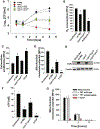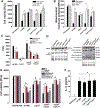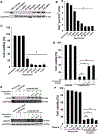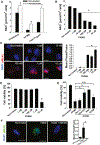NAD+ Depletion Triggers Macrophage Necroptosis, a Cell Death Pathway Exploited by Mycobacterium tuberculosis
- PMID: 29996103
- PMCID: PMC6136256
- DOI: 10.1016/j.celrep.2018.06.042
NAD+ Depletion Triggers Macrophage Necroptosis, a Cell Death Pathway Exploited by Mycobacterium tuberculosis
Abstract
Mycobacterium tuberculosis (Mtb) kills infected macrophages by inhibiting apoptosis and promoting necrosis. The tuberculosis necrotizing toxin (TNT) is a secreted nicotinamide adenine dinucleotide (NAD+) glycohydrolase that induces necrosis in infected macrophages. Here, we show that NAD+ depletion by TNT activates RIPK3 and MLKL, key mediators of necroptosis. Notably, Mtb bypasses the canonical necroptosis pathway since neither TNF-α nor RIPK1 are required for macrophage death. Macrophage necroptosis is associated with depolarized mitochondria and impaired ATP synthesis, known hallmarks of Mtb-induced cell death. These results identify TNT as the main trigger of necroptosis in Mtb-infected macrophages. Surprisingly, NAD+ depletion itself was sufficient to trigger necroptosis in a RIPK3- and MLKL-dependent manner by inhibiting the NAD+ salvage pathway in THP-1 cells or by TNT expression in Jurkat T cells. These findings suggest avenues for host-directed therapies to treat tuberculosis and other infectious and age-related diseases in which NAD+ deficiency is a pathological factor.
Keywords: MLKL; NAD(+); RIPK3; TNT; cell death; mitochondria; necroptosis; toxin; tuberculosis.
Copyright © 2018 The Authors. Published by Elsevier Inc. All rights reserved.
Conflict of interest statement
DECLARATION OF INTERESTS
The authors declare no competing interests.
Figures






Similar articles
-
NAD hydrolysis by the tuberculosis necrotizing toxin induces lethal oxidative stress in macrophages.Cell Microbiol. 2020 Jan;22(1):e13115. doi: 10.1111/cmi.13115. Epub 2019 Oct 23. Cell Microbiol. 2020. PMID: 31509891 Free PMC article.
-
The tuberculosis necrotizing toxin is an NAD+ and NADP+ glycohydrolase with distinct enzymatic properties.J Biol Chem. 2019 Mar 1;294(9):3024-3036. doi: 10.1074/jbc.RA118.005832. Epub 2018 Dec 28. J Biol Chem. 2019. PMID: 30593509 Free PMC article.
-
Susceptibility of Mycobacterium tuberculosis-infected host cells to phospho-MLKL driven necroptosis is dependent on cell type and presence of TNFα.Virulence. 2017 Nov 17;8(8):1820-1832. doi: 10.1080/21505594.2017.1377881. Epub 2017 Nov 24. Virulence. 2017. PMID: 28892415 Free PMC article.
-
RIPK1 and RIPK3: critical regulators of inflammation and cell death.Trends Cell Biol. 2015 Jun;25(6):347-53. doi: 10.1016/j.tcb.2015.01.001. Epub 2015 Feb 4. Trends Cell Biol. 2015. PMID: 25662614 Review.
-
The Inflammatory Signal Adaptor RIPK3: Functions Beyond Necroptosis.Int Rev Cell Mol Biol. 2017;328:253-275. doi: 10.1016/bs.ircmb.2016.08.007. Epub 2016 Sep 22. Int Rev Cell Mol Biol. 2017. PMID: 28069136 Free PMC article. Review.
Cited by
-
Understanding Metabolic Regulation Between Host and Pathogens: New Opportunities for the Development of Improved Therapeutic Strategies Against Mycobacterium tuberculosis Infection.Front Cell Infect Microbiol. 2021 Mar 16;11:635335. doi: 10.3389/fcimb.2021.635335. eCollection 2021. Front Cell Infect Microbiol. 2021. PMID: 33796480 Free PMC article. Review.
-
Targeting necroptosis: a promising avenue for respiratory disease treatment.Cell Commun Signal. 2024 Aug 28;22(1):418. doi: 10.1186/s12964-024-01804-6. Cell Commun Signal. 2024. PMID: 39192326 Free PMC article. Review.
-
Virulence-Associated Secretion in Mycobacterium abscessus.Front Immunol. 2022 Jul 8;13:938895. doi: 10.3389/fimmu.2022.938895. eCollection 2022. Front Immunol. 2022. PMID: 35880173 Free PMC article. Review.
-
Therapeutic Potential of Emerging NAD+-Increasing Strategies for Cardiovascular Diseases.Antioxidants (Basel). 2021 Dec 3;10(12):1939. doi: 10.3390/antiox10121939. Antioxidants (Basel). 2021. PMID: 34943043 Free PMC article. Review.
-
Understanding the Link between Inflammasome and Apoptosis through the Response of THP-1 Cells against Drugs Using Droplet-Based Microfluidics.ACS Omega. 2022 May 2;7(19):16323-16332. doi: 10.1021/acsomega.1c06569. eCollection 2022 May 17. ACS Omega. 2022. PMID: 35601322 Free PMC article.
References
-
- Butler RE, Krishnan N, Garcia-Jimenez W, Francis R, Martyn A, Mendum T, Felemban S, Locker N, Salguero FJ, Robertson B, and Stewart GR (2017). Susceptibility of Mycobacterium tuberculosis-infected host cells to phospho-MLKL driven necroptosis is dependent on cell type and presence of TNFα. Virulence 8, 1820–1832. - PMC - PubMed
Publication types
MeSH terms
Substances
Grants and funding
LinkOut - more resources
Full Text Sources
Other Literature Sources
Molecular Biology Databases
Miscellaneous

